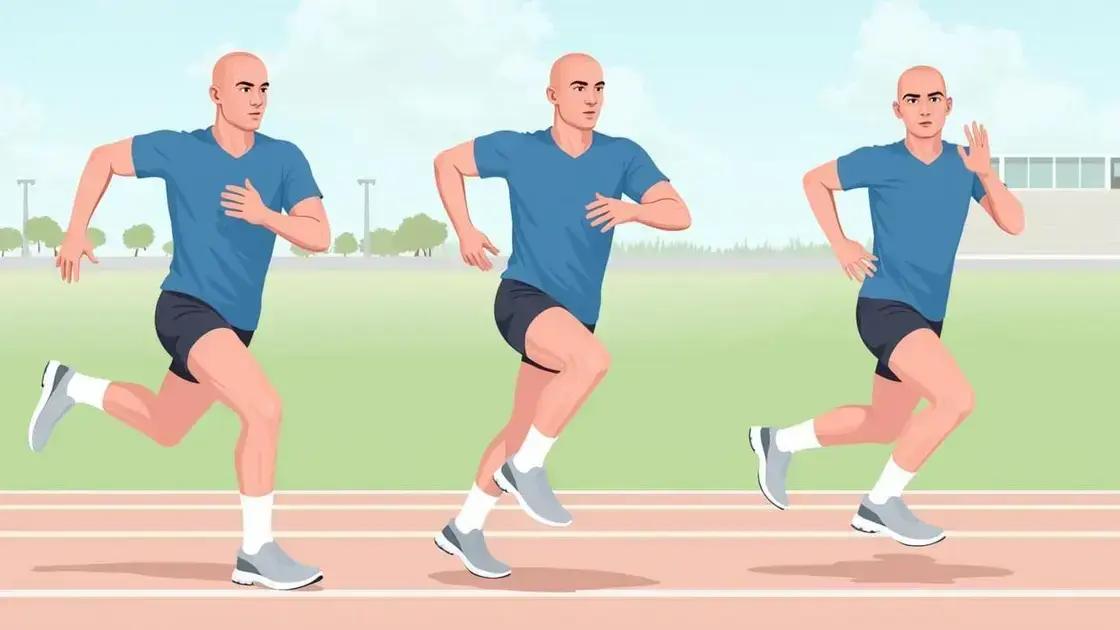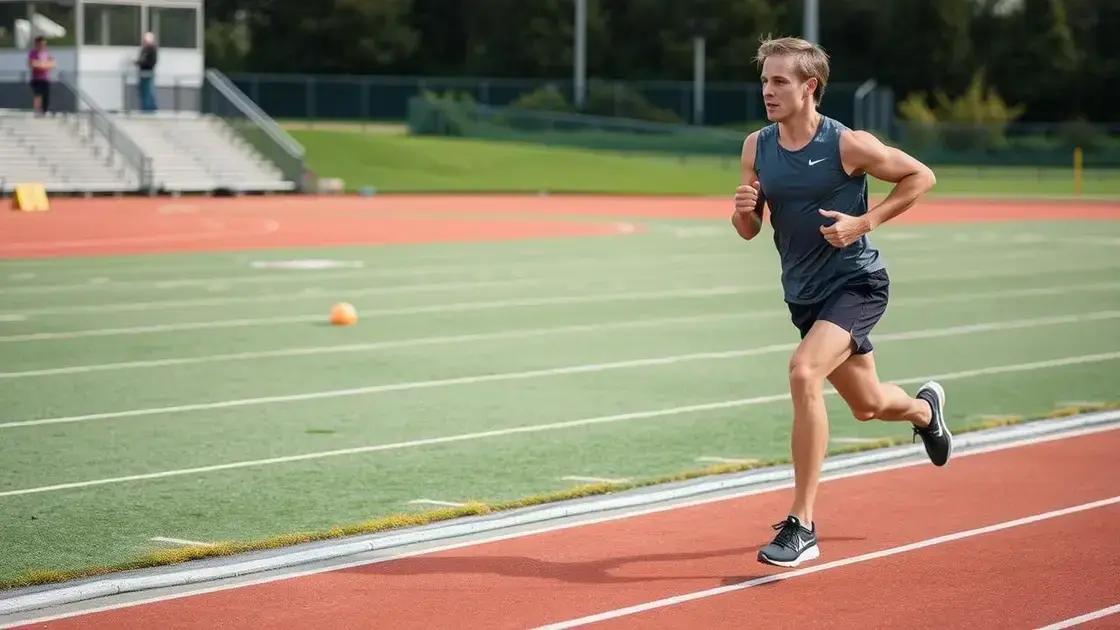To develop better running form, focus on understanding its importance through essential drills like high knees and butt kicks. Incorporate these drills into your training routine, track your progress using video analysis and GPS metrics, and ensure consistent practice to enhance efficiency and reduce injury risks.
If you want to improve your running performance and prevent injuries, understanding how to develop better running form with drills is essential. Good form not only enhances efficiency but also reduces the risk of strains and sprains. In this post, we will explore the importance of running form, essential drills you can practice, and how to seamlessly incorporate these workouts into your training routine.
Understanding the Importance of Running Form

Understanding the importance of running form is crucial for every runner, whether you are a beginner or an experienced athlete. Good running form helps maximize your efficiency and minimize the risk of injury. When you run with proper form, your body moves in a more natural, efficient way, which allows you to conserve energy and run faster.
Why is Running Form Important?
Running with poor form can lead to a range of injuries, including shin splints, knee pain, and stress fractures. Improving your running form can greatly reduce the chances of these injuries by ensuring that your body absorbs the impact correctly.
Key Components of Running Form
There are several key components to running form that you should pay attention to:
- Posture: Stand tall with your head up and shoulders relaxed. Your body should be aligned, with a straight spine.
- Foot Strike: Aim to land your feet underneath your body, rather than in front of you. A midfoot strike is often recommended.
- Arm Movement: Keep your arms bent at about 90 degrees and move them naturally at your sides. This helps balance your body while running.
- Cadence: Focus on a higher cadence, or steps per minute, to improve efficiency and reduce the risk of injury.
By understanding these components, you can start to develop better running form. This understanding will also be helpful as you incorporate specific drills into your training routine in the following sections.
Essential Drills for Better Running Technique

To improve your running form, practicing essential drills is important. These drills focus on key aspects of running technique, helping you build strength, flexibility, and coordination.
1. High Knees Drill
This drill helps increase your knee lift and strength in your legs. Stand in place and jog by driving your knees up toward your chest. Aim for a quick tempo and focus on maintaining good posture.
2. Butt Kicks
Butt kicks focus on increasing your stride length and improving leg movement. While jogging in place, intentionally kick your heels to your glutes. Keep your upper body relaxed and avoid leaning forward.
3. Skipping Drill
This drill enhances your coordination and fosters a good rhythm when running. Move forward with a skipping motion, focusing on getting your knees high while pushing off the ground with your toes. Make sure to keep your arms moving naturally.
4. Stride Outs
Stride outs are great for improving your speed and running economy. Find a flat and open area and gradually increase your speed over 30 meters before slowly returning to a jog. Focus on maintaining good form throughout the drill.
Incorporating these essential drills into your regular training can significantly develop your running technique. Remember to perform them consistently to see improvement in your overall running form.
Incorporating Drills into Your Training Routine

Incorporating drills into your training routine is vital for enhancing your running form. By adding these drills regularly, you can build strength and improve technique. Here are some tips for integrating drills into your schedule:
1. Schedule Specific Drill Days
Choose one or two days a week dedicated to drills. This allows you to focus on form and technique without the pressure of long runs. Consider incorporating them on lighter training days.
2. Warm-Up Prior to Drills
Always begin with a proper warm-up to prepare your muscles. A few minutes of dynamic exercises like leg swings and arm circles can help your body adjust before moving into drills.
3. Include Drills in Your Workouts
You can include drills as part of a larger workout. For instance, after a short warm-up jog, spend 10-15 minutes doing drills before finishing with an easy run. This mix enhances both form and endurance.
4. Track Your Progress
Keep a training log to track your improvements. Note how each drill affects your form and running performance. Celebrate small victories, such as improved speed or reduced fatigue.
These steps will ensure that drills become an effective part of your training routine, leading to better running form over time.
Measuring Improvement in Your Running Form

Measuring improvement in your running form is essential to track your progress effectively. Knowing how to assess your technique will help you see the results of your hard work. Here are some methods to evaluate your running form:
1. Video Analysis
Recording yourself while you run can provide valuable insights. Use a smartphone or camera to capture your form from different angles. Analyze your posture, foot strike, and arm movement to identify areas for improvement.
2. Running Watch Metrics
Using a GPS running watch can help you track key metrics like pace, distance, and cadence. Monitoring your average pace and stride length over time can indicate if your form is improving.
3. Heart Rate Monitoring
Keeping track of your heart rate during runs is another way to measure form. If your heart rate decreases for the same pace over time, it suggests improved efficiency and better running form.
4. Feedback from a Coach or Peer
Getting feedback from a coach or running buddy can help you make necessary adjustments. They can observe your form and provide tips on what to improve or change to enhance your performance.
By using these methods, you can effectively measure your progress and ensure that your efforts in developing better running form are paying off.
In Summary: Improve Your Running Form with Drills
Improving your running form is essential for both efficiency and injury prevention. By understanding the importance of good form and engaging in essential drills, you can enhance your technique and performance.
Incorporating these drills into your training routine regularly will help build strength and improve your overall running experience. Measuring your progress through video analysis, running metrics, and feedback ensures you stay on the right path.
Remember, consistent practice and evaluation are key to developing better running form. Embrace these strategies to unlock your true running potential.
FAQ – Frequently Asked Questions about Developing Better Running Form
Why is running form important?
Good running form improves efficiency and reduces the risk of injuries, allowing you to run faster with less fatigue.
What drills can I do to improve my running technique?
Essential drills include high knees, butt kicks, skipping, and stride outs, all designed to enhance various aspects of your running form.
How often should I incorporate drills into my training?
Aim to include drills 1-2 times a week, ideally on lighter training days, to ensure focus on form without added fatigue.
How can I track my progress in running form?
You can track progress through video analysis, GPS or heart rate metrics, and by seeking feedback from coaches or running partners.
Can I measure my improvement in efficiency?
Yes, tracking your pace and heart rate during runs can show if you are becoming more efficient as your form improves.
What should I do if I notice bad running form?
Focus on drills that target the specific aspects of form you struggle with, and consider seeking out professional insight for corrective techniques.












